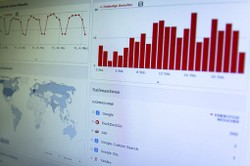Marketers use web analytics tools to collect, measure and analyze web data to understand and optimize the website and online marketing campaigns. These tools are essentially used to understand how the campaigns are performing, in particular, how users behave on their website and how they interact with their content.
Furthermore, it can help you understand what content on site is working well and what objectives you want it to achieve as well as understanding how traffic from different sources differ in the behavior on site.

The importance of using web analytics
by Brendon
Web analytics is the collection, measurement, analysis and reporting of web data for purposes of understanding and optimizing web usage.
Understanding the market
Web analytics enables marketers to understand their market better and they can provide insights into market and seasonal through the increases and decreases in demand and conversions. This may include insight into market interest and demand from traffic entering the site as well as onsite searches and conversions.
Optimizing content and campaigns
The insights marketers obtain through the analytics help to optimize content and campaigns by providing data on:
- what content to update or create to increase engagement
- which campaigns to increase investment in
- what changes to make on the website to improve user experience
- what updates to make to the positioning of products and services to make overall presentation more appealing to the customer
Continual Improvements
This analysis allows marketers to make smarter decisions on their marketing spend, therefore driving increased levels of traffic and improving the conversion rate.
Analysis is not a once off and should be used to continually increase knowledge and constantly improve campaigns and onsite experiences to increase traffic and conversions even further.
Improving marketing strategies
Marketers can use insights collected through web analytics to gain a better understanding of what is and what isn't working in their campaigns or on their website. They can therefore, make more informed decisions on their future marketing strategies and activities in order to optimize and improve future activity.
Some of the main tools used are:
Google Analytics: the most commonly used analytics tool worldwide and has both free and paid versions.
Adobe Analytics: an enterprise solution that is part of the Adobe Marketing Cloud and has only a paid license.
Webtrends: another paid-for enterprise solution that has integrated heat mapping software.
Kissmetrics: this has a CRM as well as email marketing packages alongside its analytics tools and offers only paid subscriptions.
Woopra: an analytics package that also has integrated CRM analysis, with both free and paid levels.
Piwik: an open-source analytics tool that offers both paid and free versions.
Benefits of using Google Analytics
Google Analytics is the most commonly used web analytics tool and has both a free and paid version.
The main benefits to Google Analytics 360 (paid version) is:
- Dedicated support and training
- Higher customization abilities
- Higher processing limits
- Un-sampled reports
- Fresher data
Complimentary tools
There are, however, other analytics tools that provide insight into online campaigns and activity which compliment information from Google Analytics.
Most of these tools provide insights on campaign activity such as impressions, click through rates and costs incurred, for example, Google Adwords, Facebook and Bing Ads.
Furthermore, Hubspot allows for deeper marketing analytics, integrating many marketing channels into one analysis software.
The importance of a measurement plan
It is important to have a clear business measurement plan with defined objectives and key performance indicators which can be benchmarked and measured.
This will enable marketers to ensure relevant elements are tracked and performance is measured accurately.
In order to trust and assess a measurement plan and defined KPI's, marketers need to be able to trust the information they are gathering and analyzing.
If the data gathered has flaws or inaccurate, each action taken on the basis of this data could be detrimental to your website and conversion goals.
Best practices
- Always ensure that relevant campaign tracking is in place before a campaign begins.
- The success of using analytics to improve marketing campaigns and performance rests on ensuring that the data collected is accurate and that it is interpreted correctly.
Understanding business objectives
This measurement plan arises from understanding what the business goals are and what the objectives the website needs to achieve in order to reach these goals. This creates a clearer picture of how control and campaigns should perform in order to reach these goals.
You might also like
There is a Google alternative? Really?When doing a research, don't rely on Google only. To stand out from the crowd...
Effective Thumbnail Images for Pinterest Success in Promoting ...You want your articles to be liked and, more important, pinned and repinned, ...











 The nature and assessment of mental disorderson 05/11/2016
The nature and assessment of mental disorderson 05/11/2016
 Are psychological assessments reliable?on 05/10/2016
Are psychological assessments reliable?on 05/10/2016



Comments
Brendon, Thank you for the practical information and product lines. Google Analytics is most familiar to me.
Is each of the other main tools within niches that are profitable or would Adobe, Kissmetrics, Piwik, Webtrends and Woopra be interested in greater competition with Google? It seems that Adobe, Kissmetrics and Webtrends superficially might be comfortable and profitable in their niches since they offer no free versions.